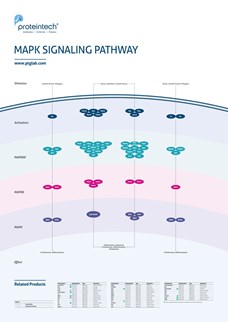MAPK Pathway: New Poster Available
Download or request a pathway poster for your lab
All the posters in the Proteintech library are available in PDF format or can be requested as a hard copy.
MAPK Overview
Mitogen-activated protein kinase (MAPK) pathways relay, amplify, and integrate signals from a diverse range of stimuli and elicit an appropriate physiological response, including cellular proliferation, differentiation, development, inflammatory responses, and apoptosis, in mammalian cells. At least three MAPK families have been characterized: extracellular signal-regulated kinase (ERK), Jun kinase (JNK/SAPK), and p38 MAPK (1).
Cancer can be perceived as a disease of communication between and within cells, and MAPK pathways feature this prominently. ERK is a downstream component of an evolutionarily conserved signaling module that is activated by the Raf serine/threonine kinases. Raf activates the MAPK/ERK kinase (MEK)1/2 dual-specificity protein kinases, which then activate ERK1/2. Moreover, the Raf-MEK-ERK pathway is a key downstream effector of the Ras small GTPase, one of the most frequently mutated oncogenes in human cancers (2). Finally, Ras is a key downstream effector of the epidermal growth factor receptor (EGFR), which is mutationally activated and/or overexpressed in a wide variety of human cancers. Stress-activated pathways, such as Jun N-terminal kinase and p38, largely seem to counteract malignant transformation. The balance and integration between these signals may vary widely in different tumors but are important for both the outcome and the sensitivity to drug therapy (3).
 |
Download the MAPK Pathway here |
Request a printed MAPK pathway poster here |
Related Antibodies
| AP1,JUN,P39 | MAPKAPK3 | PAK2 |
| CHOP | MEK4 | PKA C-Beta-Specifc |
| CRK | MEK6 | RAF1 |
| GRB2 | MEKK3 | RSK2 |
| JIP1 | P38 | TNFR1 |
| JNK2 | P38 MAPK | TRAF6 |
Browse more pathway posters here |
References
- MAPK signal pathways in the regulation of cell proliferation in mammalian cells.
- Targeting the Raf-MEK-ERK mitogen-activated protein kinase cascade for the treatment of cancer.
- MAP kinase signalling pathways in cancer.